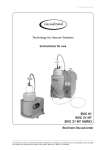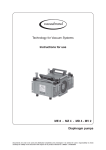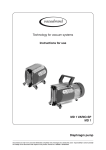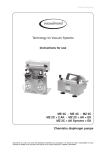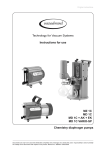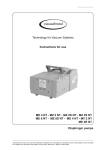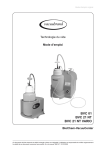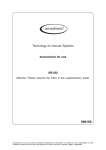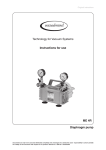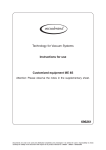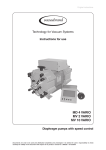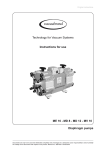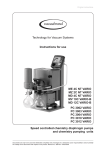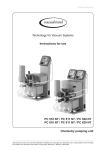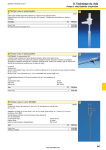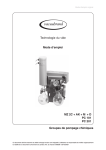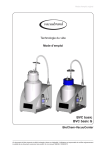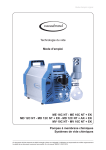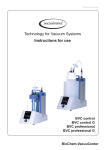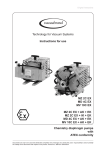Download - Vacuubrand.com
Transcript
page 1 of 27 Technology for Vacuum Systems Instructions for use BVC 21 BVC 01 BioChem-VacuuCenter Documents are only to be used and distributed completely and unchanged. It is strictly the users´ responsibility to check carefully the validity of this document with respect to his product. Manual-no.: 999054 / 15/12/2009 page 2 of 27 Dear customer, Your VACUUBRAND diaphragm pumps should support you for a long time without trouble and with maximal power. Thanks to our long practical experience we have much information how you could ensure powerful application and personal safety. Please read these instructions for use before the initial operation of your pump. VACUUBRAND diaphragm pumps are the result of many years of experience in construction and practical operation of these pumps combined with the latest developments in material and manufacturing technology. Our quality maxim is the ”zero fault principle”: Every diaphragm pump, leaving our company, is tested intensively including an endurance run of 18 hours. Therefore also faults, which occur rarely, are identified and can be eliminated immediately. The achievement of the specifications after the endurance run is tested for every pump. Every VACUUBRAND pump achieves the specifications. We feel obliged to this high quality standard. We know that the vacuum pump can not take a part of your real work and hope that our products contribute to an effective and trouble-free realisation of your work. Yours VACUUBRAND GMBH + CO KG After sales service:Contact your local dealer or call +49 9342 808-193. Documents are only to be used and distributed completely and unchanged. It is strictly the users´ responsibility to check carefully the validity of this document with respect to his product. Manual-no.: 999054 / 15/12/2009 page 3 of 27 Contents Safety information! ....................................................................................................4 Technical data............................................................................................................ 8 Use and operation ...................................................................................................12 Accessories - spare parts .......................................................................................16 Troubleshooting ...................................................................................................... 17 Replacing diaphragms and valves ........................................................................ 18 Assembling of components ................................................................................... 22 Cleaning and decontaminating .............................................................................. 23 Notes on return to the factory ................................................................................ 24 Health and safety clearance form ..........................................................................25 Attention! Important notes! Not permitted! Misuse may cause damage. Caution! Hot surface! Isolate equipment from mains. Note. Documents are only to be used and distributed completely and unchanged. It is strictly the users´ responsibility to check carefully the validity of this document with respect to his product. Manual-no.: 999054 / 15/12/2009 page 4 of 27 Safety information! Remove all packing material, remove the product from its packing-box, remove the protective covers from the inlet and outlet ports and keep them. Inspect the equipment. If the equipment is damaged, notify the supplier and the carrier in writing within three days; state the item number of the product together with the order number and the supplier’s invoice number. Retain all packing material for inspection. Do not use the equipment if it is damaged. If the equipment is not used immediately, replace the protective covers. Store the equipment in suitable conditions. ☞ Read and comply with this manual before installing or operating the equipment. ☞ Transport the pump at the provided handles. ☞ If the equipment is used in combination with hazardous materials (e. g. in medical-microbiological laboratories) check all relevant safety and health requirements and determine the applicability of regulatory limitations prior to use if necessary. ☞ For aspiration of liquids connect the system BVC 01 to a suitable vacuum supply. ☞ Before operating the equipment read and comply with the sec- tion ”Cleaning and decontamination”! Ensure that the equipment is suitable for the intended application. Use the system only for aspiration of liquids. ☞ The system is not designated to be used in contact with the human body. ☞ Comply with notes on correct vacuum and electrical connections. ☞ Make sure that the individual components are only connected, combined and operated according to their design and as indicated in the instructions for use. Comply with national safety regulations and safety requirements concerning the use of vacuum and electrical equipment. ☞ Equipment must be connected only to a suitable fused and protected electrical supply and a suitable earth point. Failure to connect the motor to ground may result in deadly electrical shock. ☞ The supply cable may be fitted with a moulded European IEC plug or a plug suitable for your local electrical supply. If the plug has been removed or has to be removed, the cable will contain wires colour coded as follows: green or green and yellow: earth; blue or white: neutral; brown or black: live. ☞ Check that mains voltage and current conform with the equipment (see rating plate): Pumps with dual-voltage motor (100-120 V / 200-230 V; 50/60 Hz): ☞ The equipment must be connected to a suitable fused and protected electrical supply and a suitable earth point only, provide slow-blow fuse according to voltage supply (see ”Technical data”). ☞ Check that the voltage changeover switch is positioned correctly. Attention: If the pump is switched on with the voltage not correctly selected, the motor may be damaged! Documents are only to be used and distributed completely and unchanged. It is strictly the users´ responsibility to check carefully the validity of this document with respect to his product. Manual-no.: 999054 / 15/12/2009 page 5 of 27 ☞ If the equipment is brought from cold environment into a room for operation, allow the equipment to warm up (pay attention to water condensation on cold surfaces). ☞ Make sure ventilation is adequate if pump is installed in a housing or if ambient temperature is elevated. Comply with all relevant safety requirements (regulations and guidelines) and adopt suitable safety measures. ☞ Provide a firm level platform for the equipment and check that the system to be evacuated is mechanically stable and that all fittings are secure. Attention: Flexible elements tend to shrink when evacuated. Due to the high compression ratio of the pumps, pressure at the outlet port might be generated being higher than the max. permitted pressure compatible with the mechanical stability of the system. ☞ Comply with maximum permitted pressures and pressure differences, see section ”Technical data”. Do not operate the pump with overpressure at the inlet. Do not permit any uncontrolled pressurizing (e. g. make sure that the exhaust pipeline cannot become blocked). If you have an exhaust-isolation valve, make sure that you cannot operate the equipment with the valve closed. Risk of bursting! ☞ Avoid overpressure of more than 0.2 bar in case inert gas is connected. ☞ The diameter of the inlet and outlet pipeline should be at the least as large as the diameter of the pump connection pipelines. Maximum liquid level in collecting bottle: approx. 80 %, depending on the application (in case of low boiling liquids or in case of suction of liquids which tend to foam, the maximum liquid level might be reduced). To the best of our knowledge the equipment is in compliance with the requirements of the applicable EC-directives and harmonized standards (see ”Declaration of conformity”) with regard to design, type and model, especially directive IEC 1010. This directive gives in detail conditions, under which the equipment can be operated safely (see also IP degree of protection). ☞ Adopt suitable measures in case of differences, e. g. using the equipment outdoors, installation in altitudes of more than 1000 m above mean sea level, conductive pollution or dewiness. Pay attention to symbol ”hot surfaces” on the equipment. ☞ Adopt suitable measures to prevent any danger arising from the formation of hot surfaces or electric sparks. The pumps have no approval for operation in or for pumping of potentially explosive atmospheres. If pumping different substances, purge the pump with inert gas prior to changing the pumped media in order to pump out residues and to avoid reactions of the pumped substances with each other with and the pump material. Ensure that the materials of the wetted parts are compatible with the pumped substances, see section ”Technical data”. Take into consideration interactions and chemical reactions of the pumped media. The pumps are not suitable for pumping substances which may form deposits inside the pump. ☞ If there is a danger of the formation of deposits in the pump chamber (check inlet and outlet of the pump) inspect the pump chamber regularly and clean if necessary. Documents are only to be used and distributed completely and unchanged. It is strictly the users´ responsibility to check carefully the validity of this document with respect to his product. Manual-no.: 999054 / 15/12/2009 page 6 of 27 The pumps are not suitable to pump unstable substances and substances which react explosively under impact (mechanical stress) and/or when being exposed to elevated temperatures without air. The pumps are not suitable to pump self inflammable substances, substances which are inflammable without air and explosive substances. The pumps are not suitable for pumping dust and have no approval for operation below ground. ☞ Adopt suitable measures to prevent the release of dangerous, explosive, corrosive or polluting fluids. ☞ The user must take suitable precautions to prevent any formation of explosive mixtures in the expansion chamber or at the outlet. In case of a diaphragm crack, mechanically generated sparks, hot surfaces or static electricity may ignite these mixtures. ☞ Take adequate precautions to protect people from the effects of dangerous substances (chemicals, thermal decomposition products of fluoroelastomers), wear appropriate safety-clothing and safety glasses. ☞ Use appropriate safety work materials and methods if necessary, e. g. steam sterilization, sterilization indicators or germicides. ☞ Use the system only in combination with the integrated hydrophobic filter (sterilizable) to protect pump and environment (people). ☞ Observe the reagent manufacturer´s information. ☞ Obey applicable regulations when disposing of chemicals. Take into consideration that chemicals may be polluted. The motor is shut down by a thermal cutout in the winding. ☞ Attention: Manual reset is necessary. Switch off the pump or isolate the equipment from mains. Wait approx. five minutes before restarting the pump. ☞ Attention: In case of supply voltage below 100V, the lock of the cutout might be restricted and the pump might restart on its own after sufficient cooling down. Take suitable precautions, if an automatic restart of the pump may lead to a critical dangerous situation. ☞ Avoid high heat supply (e. g. due to hot process gases). ☞ Ensure sufficient air admittance if pump is installed in a housing. Due to the residual leak rate of the equipment, there may be an exchange of gas, albeit extremely slight, between the environment and the vacuum system. ☞ Adopt suitable measures to prevent contamination of the pumped substances or the environment. Ensure that in case of failure the pump and the vacuum system always will turn into a safe status. Never operate a defective or damaged device. ☞ Check collecting bottle for fissures regularly. Do never use a collecting bottle with fissures nor expose it to vacuum. ☞ In case of diaphragm cracks or leaks in the manifold pumped substances might be released into the environment or into the pump housing. To reduce the risk of leaks, ask for a diaphragm pump with additional safety diaphragm. ☞ Obey especially notes on operation and use and maintenance. ☞ Failure of the pump (e. g. due to power failure) must not lead to a critical dangerous situation under any circumstances. Use only genuine spare parts and accessories. ☞ Otherwise safety and performance of the equipment as well as the electromagnetic compatibility of the equipment might be reduced. Possibly the CE mark or the C/US conformity becomes void if not using genuine spare parts. Documents are only to be used and distributed completely and unchanged. It is strictly the users´ responsibility to check carefully the validity of this document with respect to his product. Manual-no.: 999054 / 15/12/2009 page 7 of 27 Notes concerning the sterilization of wetted parts (see ”Technical data”) see section ”Cleaning and decontaminating”. ☞ It is the user´s responsibility to ensure effective sterilization. The A-weighted emission sound pressure level of the pump does not exceed 70 dB(A). Measurement according to EN ISO 2151:2004 and EN ISO 3744:1995 with standard silencer or exhaust tube at outlet. Ensure that maintenance is done only by suitable trained and supervised technicians. Ensure that the maintenance technician is familiar with the safety procedures which relate to the product processed by the vacuum system and that the equipment, if necessary, is appropriately decontaminated before starting maintenance. Comply with local and national safety regulations. Wear parts have to be replaced regularly. In case of normal wear the lifetime of the diaphragms and valves is > 10000 operating hours. Bearings have a typical durability of 40000 h. Motor capacitors have a typical durability in the range of 10000 to 40000 h depending strongly on the operation conditions like ambient temperature, humidity or load. ☞ Check every capacitor regularly by measuring its capacity and estimating its operation time. Exchange old capacitors early enough to prevent a failure. If an overaged motor capacitor fails it might get hot and even melt and may cause a flame to form which could be dangerous for persons and equipment in the vicinity. The capacitors have to be replaced by an electrician. ➨ Isolate equipment from mains and wait two minutes before starting maintenance to allow the capacitors to discharge. ☞ Attention: The pump might be contaminated with process chemicals which have been pumped during operation. Ensure that the pump is decontaminated before maintenance and take adequate precautions to protect people from the effects of dangerous substances if contamination has occurred. ☞ Ensure that the pump cannot be operated accidentally. Never operate the pump if covers or other parts of the pump are disassembled. Never operate a defective or damaged pump. ☞ Before starting maintenance vent the pump and allow sufficient cooling of the pump. Drain condensate, if applicable. In order to comply with law (occupational, health and safety regulations, safety at work law and regulations for environmental protection) vacuum pumps, components and measuring instruments returned to the manufacturer can be repaired only when certain procedures (see section ”Notes on return to the factory”) are followed. Documents are only to be used and distributed completely and unchanged. It is strictly the users´ responsibility to check carefully the validity of this document with respect to his product. Manual-no.: 999054 / 15/12/2009 page 8 of 27 Technical data Type Max. pumping speed 50/60 Hz Ultimate total pressure (absolute) BVC 21 BVC 01 Pump Valve m 3/ h 1.9/2.2 - mbar 100 - 120 W 30 VA ther mal cutout - 2.6/1,3* 1.1/1.1 - N o m i n a l p ow e r Motor protection Rated current draw 100-120/200-230 V~ 50/60 Hz 230 V~ 50/60 Hz A A 100-120 V~ +5%-10% 50/60 Hz* 200-230 V~ +/-10% 50/60 Hz* 230 V~ +/-10% 50/60 Hz M a x . p e r m i t t e d ra n g e o f s u p p l y voltage. Pay attention to motor rating plate! D e gr e e o f p r o t e c t i o n I E C 5 2 9 Volume collecting bottle IP 40 l Adapter for VHC Hydrophobic filter : Type Manufacturer Nominal pore diameter System System 4 4 p a s t e u r p i p e t t e s, c a p i l l a r i e s, pipette tips (100 µl) Midisar t® 2000 Sar tor ius 0.2 µm D e gr e e o f p r o t e c t i o n I E C 5 2 9 Overall dimensions L x W x H Mass * IP 52 mm 420 x 300 x 500 250 x 300 x 500 kg 11 4 pump with dual range motor 100-120/200-230 V 50/60 Hz We reserve the right for technical modifications without prior notice! Documents are only to be used and distributed completely and unchanged. It is strictly the users´ responsibility to check carefully the validity of this document with respect to his product. Manual-no.: 999054 / 15/12/2009 page 9 of 27 Components Collecting bottle VTC Bottle S c r ew c a p H o s e n o z z l e a t s c r ew c a p Blind cap Tube inside the bottle Tube between bottle and pump Coupling Tube Filter D i a p h ra g m Housing A s p i r a t i o n c o n t ro l l e r V H C Tube Adapter Pump Head cover D i a p h ra g m D i a p h ra g m c l a m p i n g d i s c Valve O-r ing (catchpot) Vacuum connections Pressure control device Wetted par ts PP PP PPS PPS 40% glass fibre PE PVC PP, stainless steel, EPDM PVC PTFE PP silicon caoutchouc PVC or PP aluminium PTFE aluminium FFKM FPM a l u m i n i u m a n o d i ze d PA / FPM We reserve the right for technical modifications without prior notice! Documents are only to be used and distributed completely and unchanged. It is strictly the users´ responsibility to check carefully the validity of this document with respect to his product. Manual-no.: 999054 / 15/12/2009 page 10 of 27 BioChem-VacuuCenter BVC 21 fig.: BVC 21 230 V 50/60 Hz connecting tube filter coupling inlet diaphragm pump with coupling (double sided sealed if removed) blind cap (for further connections) screw cap diaphragm pump collecting bottle outlet on/off switch at terminal box catchpot pressure control device ➨ Connect the tube of the VacuuHandControl to the hose nozzle of the coupling of the bottle head. ➨ Assemble the connecting tube with filter. BVC 21 100-120/200-230 V 50/60 Hz: terminal box on/off switch underneath warning label Documents are only to be used and distributed completely and unchanged. It is strictly the users´ responsibility to check carefully the validity of this document with respect to his product. Manual-no.: 999054 / 15/12/2009 page 11 of 27 BioChem-VacuuCenter BVC 01 connecting tube filter blind cap (for further connections) coupling (connection VHC) screw cap collecting bottle inlet isolation valve with coupling (double sidedly sealed if removed) pressure control device solenoid operated isolation valve hose nozzle (connection to vacuum supply) ➨ Assemble the screw cap with filter and connecting tube. ➨ Connect the tube of the VacuuHandControl to the hose nozzle of the coupling at the bottle head. VacuuHandControl VHC fixing clip thumb wheel control button adapter aspiration tube locking ring handle Documents are only to be used and distributed completely and unchanged. It is strictly the users´ responsibility to check carefully the validity of this document with respect to his product. Manual-no.: 999054 / 15/12/2009 page 12 of 27 Use and operation Installation: ☞ Max. ambient temperature: 40 °C ➨ Remove the protective foils from the fittings at the flask head and the protective covers from the inlet of the diaphragm pump or the solenoid operated valve. ➨ Assemble the connecting tube with filter between the bottle head and the inlet of the diaphragm pump (BVC 21) or the inlet of the solenoid operated valve (BVC 01). ➨ Connect the aspiration tube of the VacuuHandControl VHC to the coupling at the bottle head. ➨ Connect the female connector of the mains cable to the pressure control device. ☞ Make sure ventilation is adequate if pump is installed in a housing or if ambient temperature is elevated. Keep a distance of min. 20 cm between fans and ambient parts. ☞ If pump is installed in altitudes of more than 1000 m above mean sea level check compatibility with applicable safety requirements, e. g. IEC 60034 (motor may overheat due to insufficient cooling). ☞ Before switching on the pump check that mains voltage and current conform with the equipment! Pump with dual-voltage motor: ☞ Check that the voltage changeover switch underside the terminal box is positioned correctly. Attention: If the pump is switched on with the voltage not correctly selected, the motor may be damaged! Pay attention to the warning label on the on/off switch and remove after having set the voltage changeover switch to the correct position! Selecting the supply voltage: Attention: Before starting the pump, check that the voltage selection switch underside the terminal box is correctly positioned. Change the selection at the voltage changeover switch only if the pump is separated from mains. Voltage selection switch: Use a screw driver to adjust the supply voltage on the voltage changeover switch at the terminal box of the pump: ”115” corresponds to 100-120V and ”230” corresponds to 200-230V. During operation: The pump achieves its pumping speed, ultimate total vacuum and vapour pumping rate only at operating temperature (after approx. 15 minutes). ☞ Prevent internal condensation, transfer of liquids or dust. The diaphragm and valves will be damaged, if liquids are transfered through the pump in significant amounts. Documents are only to be used and distributed completely and unchanged. It is strictly the users´ responsibility to check carefully the validity of this document with respect to his product. Manual-no.: 999054 / 15/12/2009 page 13 of 27 The motor is shut down by a thermal cutout in the winding. ☞ Manual reset is necessary. Switch off the pump or isolate the equipment from mains. Wait approx. five minutes before restarting the pump. Identify cause of failure and eliminate. ☞ Attention: In case of supply voltage below 100V, the lock of the cutout might be restricted and the pump might restart on its own after sufficient cooling down. Take suitable precautions, if an automatic restart of the pump may lead to a critical dangerous situation. Operate the system only with the integrated hydrophobic filter. ☞ Protection of the pump against liquids and contamination. ☞ Protection of the environment/user against contamination (risk of infection!). An automatic pressure control switches the vacuum pump according to the requirements and provides the appropriate vacuum for the next aspiration. Max. permitted power draw at the vacuum pump connection: 6A ohmic, 1.5A inductive. Shutdown: Short-term: Has the pump been exposed to condensate? ➨ Allow the pump to continue to run at atmospheric pressure for a few minutes. Has the pump been exposed to media which may damage the pump materials or form deposits? ➨ Check and clean pump heads if necessary. Long-term: ➨ Take measures as described in section short-term shutdown. ➨ Separate pump from the apparatus. ➨ Close inlet and outlet port (e. g. with transport caps). ➨ Store the pump in dry conditions. Documents are only to be used and distributed completely and unchanged. It is strictly the users´ responsibility to check carefully the validity of this document with respect to his product. Manual-no.: 999054 / 15/12/2009 page 14 of 27 VacuuHandControl VHC The instrument allows the aspiration of excess liquids. The VHC is supplied completely with three different adapters (included in delivery) to hold with pasteur pipettes, capillaries and pipette tips (100 µl). Before aspiration: Push back the locking ring from the control button. Choose the appropriate adapter and carefully insert the pipette into the adapter. Position pipette tip by turning the fixing clip in such a way that working is comfortable and fatigue-proof. Remove adapter from fixing clip if is hard to turn. Squeeze fixing clip and turn to desired position. Put adapter back in fixing clip. Attention: Never insert filled pipettes due to risk of contamination and infection. Wear protective gloves! Aspiration of liquid: Press control button until the liquid has been aspirated. Release the control button to stop aspiration. For controlled aspiration of excess liquids, the aspiration speed can be regulated by using the integrated control button. Small amounts of liquids can be taken up manually by using the thumb wheel and then sucked into the collecting bottle. Working at different work places: Disconnect bottle VTC with VacuuHandControl VHC from the inlet of the pump. The bottle VTC is portable. If the aspiration effect ceases, connect VTC to the diaphragm pump for a short time until the pump is switched off by the automatic pressure control. After aspiration: Carefully pull pipette out of the adapter. Attention: Risk of contamination and infection. Wear protective gloves and eye protection! Dispose of pipettes according to appropriate regulations. Push the locking ring on the control button (release aspiration tube). Switch off pump. Documents are only to be used and distributed completely and unchanged. It is strictly the users´ responsibility to check carefully the validity of this document with respect to his product. Manual-no.: 999054 / 15/12/2009 page 15 of 27 catchpot The hydrophobic filter retains water and aqueous solutions also in the form of aerosols. When using solvents or due to evaporation of water, condensate may be recovered in the catchpot. ☞ Remove joint clip and catchpot and drain condensate in case. Important: Comply with applicable regulations when disposing of solvents. filter Change filter if necessary (contaminated, no or bad aspiration, pressure control device switches without demand of vacuum). ☞ Use only the original spare part and sterilize and dispose of the filter according to appropriate regulations. Note: After disinfection with alcohol allow the filter to dry completely because the filter may become clogged by alcohol. screw cap Check level of liquid in the collecting bottle regularly. Maximum liquid level in collecting bottle: approx. 80 %, depending on the application (in case of low boiling liquids or in case of suction of liquids which tend to foam, the maximum liquid level might be reduced). Emptying of the collecting bottle: ☞ Switch off pump or isolate pump from system, vent the system (release VHC). Remove the connecting tube from the filter, isolate connections in case. ☞ Remove screw cap from the collecting bottle. Remove bottle from the support. Sterilize and dispose of collected liquid according to appropriate regulations. Attention: Do not remove connections in case of liquid in the tube. Do not touch contaminated parts when removing the screw cap. Risk of infection! Wear appropriate protective clothing, e.g. gloves. Do not remove the metal fitting at the screw cap. If the fitting is loose, tighten the fitting carefully. metal fitting Documents are only to be used and distributed completely and unchanged. It is strictly the users´ responsibility to check carefully the validity of this document with respect to his product. Manual-no.: 999054 / 15/12/2009 page 16 of 27 Accessories - spare parts Collecting bottle VacuuTransContainer VTC ......... 68 80 57 (with filter, coupling and blind cap) Bottle with screw cap ............................................. 63 82 46 VacuuHandControl VHC ......................................... 68 80 56 Connection set VHC ............................................... 68 80 60 (to connect a VHC to the VTC) Silicone tube (2m) NW 6/3 ...................................... 63 81 99 (aspiration hose for VHC) Filter (hydrophobic) ............................................... 63 82 66 Silicone tube (1 m) NW 9/6 ..................................... 63 82 63 (connecting tube) PVC tube (1 m) NW 12,8/6,4 ................................... 63 82 17 Catchpot 250 ml ...................................................... 63 88 70 Joint clip ................................................................. 63 83 55 Pressure control device complete ......................... 63 82 23 Tube clamp ............................................................. 63 82 16 Documents are only to be used and distributed completely and unchanged. It is strictly the users´ responsibility to check carefully the validity of this document with respect to his product. Manual-no.: 999054 / 15/12/2009 page 17 of 27 Troubleshooting Fa u l t Possible cause R e m e dy q Pump fails to star t, system becomes vented. è Mains not plugged in, electr ical supply failure? F Plug in. Check fuse. è Motor over loaded? F A l l ow m o t o r t o c o o l , identify cause of failure. è Pressure control device defective? F Replace pressure control device or contact local distr ibuter, plug in pump d i r e c t l y i n c a s e. è A d a p t e r o r a s p i ra t i o n t u b e defective? F Replace adapter with a s p i r a t i o n t u b e. è Filter clogged? F Replace filter. è Leakage at the bottle head? F Check seals, coupling and blind cap, screw in or replace if necessar y. è No pumping speed of the pump? F Check pump directly, see section "Replacing diaphragms and valves", r e p l a c e d i a p h ra g m a n d valves if necessar y. è Leakage in the system? F Check tubing, seals, coupling and blind cap, s c r ew i n o r r e p l a c e i f necessar y. è Filter clogged? F Replace filter. è Diaphragm or valves of the pump defective? F Check pump directly, see section "maintenance", r e p l a c e d i a p h ra g m a n d valves if necessar y. è Leakage in the system? F Check seals, coupling and blind cap, screw in or replace if necessar y. è Pressure control device defective? F Replace pressure control device or contact local distr ibuter, plug in pump d i r e c t l y i n c a s e. q No aspiration at the VHC, p i p e t t e d r i p s. q Pressure control device switches frequently. q Pump is r unning continuously. A service manual with exploded view drawings, spare part lists and directions for repair is available on request (only in German or English). ☞ The service manual is for trained service people. Documents are only to be used and distributed completely and unchanged. It is strictly the users´ responsibility to check carefully the validity of this document with respect to his product. Manual-no.: 999054 / 15/12/2009 page 18 of 27 Replacing diaphragms and valves All bearings are encapsulated and are filled with long-life lubricant. Under normal operating conditions, the pump is maintenance free. The valves and the diaphragms are wear parts. If the rated ultimate vacuum is no longer achieved or in case of increased noise level, the pump interior, the diaphragms and the valves must be cleaned and the diaphragms and valves must be checked for cracks or other damage. Depending on individual cases it may be efficient to check and clean the pump heads on a regular basis. In case of normal wear the lifetime of the diaphragms and valves is > 10000 operating hours. ☞ Prevent internal condensation, transfer of liquids or dust. The diaphragm and valves will be damaged, if liquids are pumped in significant amount. If the pump is exposed to corrosive gases or vapour or in case of deposits, maintenance should be carried out frequently. ☞ Regular maintenance will improve the lifetime of the pump and also protect both personel and environment. Before starting maintenance vent the system, isolate the pump and other components from the vacuum system and the electrical supply. Drain condensate if applicable, avoid the release of pollutants. Allow sufficient cooling of the pump. Ensure that the pump cannot be operated accidentally. Never operate the pump if covers or other parts of the pump are disassembled. Never operate a defective or damaged pump. Ensure that the maintenance technician is familiar with the safety procedures which relate to the products processed by the pumping system. Attention: The pump might be contaminated with the process chemicals that have been pumped during operation. Ensure that the pump is decontaminated before maintenance and take adequate precautions to protect people from the effects of dangerous substances if contamination has occurred. ☞ Wear appropriate safety-clothing when coming in contact with contaminated components. Diaphragm ................................................................................................................................. 63 97 86 Valve .......................................................................................................................................... 63 88 36 Face wrench with torque indicator .............................................................................................. 63 75 80 ☞ Please read section ”Replacing diaphragms and valves” completely before starting maintenance. Partially the pictures show pumps in other versions. This doesn’t influence replacing diaphragms and valves of the pump. Tools: - Phillips screw driver size 2 Open-ended wrench w/f 17 Hex key size 5 Face wrench with torque indicator Documents are only to be used and distributed completely and unchanged. It is strictly the users´ responsibility to check carefully the validity of this document with respect to his product. Manual-no.: 999054 / 15/12/2009 page 19 of 27 Cleaning and inspecting the pump head: ➨ Use open-ended wrench w/f 17, remove the screw-in fittings together with the hose from the pump heads. ➨ To check the valves use hex key size 5 to remove four sockethead screws from pump head and remove housing cover with head cover and valves. ☞ Never remove parts by using a spiky or sharp-edged tool (e.g. screw driver), we recommend to use a rubber mallet or compressed air (to be blown carefully into port). ➨ Remove head cover carefully from housing cover. Note position of valves and remove them. ☞ Replace valves if necessary. ☞ Use petroleum ether or industrial solvent to remove deposits. Do not inhale. View of the disassembled pump head parts housing cover valve diaphragm clamping disc head cover diaphragm diaphragm support disc washer housing connecting rod Documents are only to be used and distributed completely and unchanged. It is strictly the users´ responsibility to check carefully the validity of this document with respect to his product. Manual-no.: 999054 / 15/12/2009 page 20 of 27 ☞ Check diaphragm for damage and replace if necessary. ➨ To do so use Phillips screw driver to remove four countersunk head screws and lift off housing plate with rating plate. ☞ Use petroleum ether or industrial solvent to remove deposits if necessary. Do not inhale. Replacing the diaphragm: ➨ Use a face wrench to remove diaphragm support disc. ➨ Check for washers under clamping disc. Make sure that the original number is reassembled. ☞ Smaller number of washers: The pump will not attain ultimate vacuum. More washers: Clamping disc will hit head cover; noise or even blockade of the pump. ➨ Position new diaphragm between diaphragm clamping disc with square head screw and diaphragm support disc. ☞ Make sure that the square head screw of the diaphragm clamping disc is correctly seated in the guide hole of the diaphragm support disc. ☞ Attention: Position diaphragm with pale side to diaphragm clamping disc (to pump chamber). ➨ Use face wrench with torque indicator (recommended: face wrench with torque indicator from VACUUBRAND, Cat.No.: 63 75 80) to assemble diaphragm clamping disc, diaphragm and diaphragm support disc (and eventually washers) to the connecting rod. ☞ Make sure that the square head screw of the diaphragm clamping disc is correctly seated in the guide hole of the diaphragm support disc. Optimum torque for the diaphragm support disc: 6 Nm. ☞ The optimum torque is achieved if the pointer in the handle of the VACUUBRAND face wrench shows to the longer marking line. Assembling pump head: ➨ By turning eccentric bushing (front of connecting rod), bring connecting rod into a position in which diaphragm is in contact with housing and centred with respect to bore. Documents are only to be used and distributed completely and unchanged. It is strictly the users´ responsibility to check carefully the validity of this document with respect to his product. Manual-no.: 999054 / 15/12/2009 page 21 of 27 Reassemble in reverse order. ➨ Install head cover, valves and housing cover. ☞ Make sure that the valves are correctly seated: Valves at the outlet with round centred opening under valve, valves at the inlet with kidney-shaped opening beside valve. ➨ By turning eccentric bushing, bring connecting rod into upper turning point position (Max. stroke of the rod). ☞ Pay attention that the diaphragm stays positioned centrally so that it will become clamped uniformly between housing and head cover. ➁ ➂ ➃ ➨ Screw in four socket head screws fixing housing cover crosswise (e. g. in the sequence ➀, ➁, ➂, ➃) first slightly, then tighten. ☞ Do not tighten until head cover is in contact with housing, torque 12 Nm. ➀ Assembling the connecting hose: ➨ Use open-ended wrench to assemble fittings with connection hose to the pump head. Individual performance check of a pump head: By measuring the pressure at the inlet port of the individual head: Use a suitable vacuum gauge (e. g. DVR 2, cat. no.: 68 29 02), make sure that it is correctly calibrated, and measure the pressure at the inlet port. A vacuum of less than 110 mbar should be indicated. ☞ If the reading is higher, recheck the pump chamber and make sure that the valves and the diaphragm are correctly seated (diaphragm concentric with bore). If the pump does not achieve the ultimate pressure: ☞ In case the diaphragm and the valves have been replaced, a run-in period of several hours is required before the pump achieves its ultimate vacuum. If the specified ultimate pressure is not achieved and if this does not change after the run-in period: Check hose connectors at pump head for leaks. If necessary recheck pump chamber. Documents are only to be used and distributed completely and unchanged. It is strictly the users´ responsibility to check carefully the validity of this document with respect to his product. Manual-no.: 999054 / 15/12/2009 page 22 of 27 Assembling of components Replacing the aspiration tube at the VHC: Ensure that there is no liquid in the tube, risk of contamination! Remove adapter from the fixing clip. While pressing the control button, pull out the aspiration tube. Assembling new aspiration tube: While pressing the control button, insert the new aspiration tube between thumb wheel and roller. Insert adapter into the aspiration tube. Support the fixing clip suitably and assemble the adapter to the fixing clip. Replacing the filter: filter Ensure that there is no liquid in the tube, risk of contamination! Remove connecting tube from the filter. Remove the filter from the piece of tube at the hose nozzle. Assemble new filter (position with the printed side towards the bottle) and assemble connecting tube. Assembling the connection set VHC: blind cap Remove the blind cap. Remove screw cap from bottle. Insert lead-through (2) with coupling (1) (Attention: Parts are sealed with adhesive for leak tightness) and with seal ring (3) to screw cap and assemble hose (5) under the screw cap with locknut (4). Adjust hose towards flask wall. Assemble screw cap. 1 2 3 4 5 Documents are only to be used and distributed completely and unchanged. It is strictly the users´ responsibility to check carefully the validity of this document with respect to his product. Manual-no.: 999054 / 15/12/2009 page 23 of 27 Cleaning and decontaminating Autoclaving: The aspiration tube and the pipettes of the VacuuHandControl VHC, the collecting bottle with bottle head and screw cap and the filter are designated for steam sterilisation at 121°C and 2 bar absolute (1 bar overpressure). Time of exposure according to DIN 58946 te = 20 minutes. It is the user´s responsibility to ensure effective autoclaving. Maximum liquid level in collecting bottle: 80 %, in case of low boiling liquids or in case of liquids which tend to foam, the maximum liquid level might be reduced. Prior to autoclaving remove the flask head from the bottle. Do not remove the metal fittings from the flask head. If necessary tighten the metal fittings only by hand (maximum torque: 3 Nm) and only if the equipment is at room temperature. Chemical disinfection A wiping and spray disinfection of the VacuuHandControl VHC is possible by using the germicide Poursept A. By and by, discolourations and changes of features of materials (e. g. resiliency, elasticity/tightness, cracking etc.) due to frequent steam sterilisations are not to be excluded. Important notes on utilisation of disinfectants During the aspiration process the collecting bottle of the pumping units BVC 21 and BVC 01 must not contain any disinfecting solutions, which corrode the materials of the pumping unit. ☞ Disinfectants, which corrode the materials of the pumping unit (see section ”Technical data”), may only be poured in the collecting bottle once it is separated from the pumping unit. ☞ In particular no disinfectants may be used, which release chlorine or oxygen radicals, e.g. sodium hypochlorite, peroxo compounds. Aggressive disinfectants like for example Chlorax can corrode the material of the collecting bottle and other components. This may lead to stress cracks and breaking of the bottle. ☞ Therefore the use of e.g. Chlorax is not allowed except for short-time cleaning of the collecting bottle. Rinse collecting bottle thoroughly afterwards to avoid residues of the disinfectant in the bottle. ☞ Using corroding disinfectants may result in damage, misfunction and/or failure of the pumping unit. ☞ Chlorine permeates the hydrophobic filter on top of the collecting bottle and damages the materials of the pump. ☞ Leaking of liquid from a damaged collecting bottle or suction tube may lead to contamination of personnel and material or to damage/destruction of wetted equipment or laboratory furniture. The use of the disinfectant Sekusept® Plus (Manufacturer: Ecolab GmbH & Co OHG, Düsseldorf) in extensive in-house testing did not cause any damaging of the collecting bottle or the vacuum pump. Hence the disinfectant Sekusept® Plus - even applicable in the collecting bottle during suction - is to be prefered. Comply with use and safety instructions of the manufacturer! ☞ Even if using disinfecting solutions after termination of the suction it is absolutely necessary to assure the compatibility of disinfectant and the parts to be disinfected. ☞ For information about the compatibility with the materials of the pumping unit ask the manufacturer of the disinfectant. ☞ The wetted materials of the pumping unit are listed in the section ”Technical data”. Documents are only to be used and distributed completely and unchanged. It is strictly the users´ responsibility to check carefully the validity of this document with respect to his product. Manual-no.: 999054 / 15/12/2009 page 24 of 27 Notes on return to the factory Repair - return - DKD calibration Safety and health of our staff, laws and regulations regarding the handling of dangerous goods, occupational health and safety regulations and regulations regarding safe disposal of waste require that for all pumps and other products the “Health and safety clearance form“ must be send to our office duly completed and signed before any equipment is dispatched to our premises. Fax or post a completed copy of the health and safety clearance form to us in advance. The declaration must arrive before the equipment. Enclose a second completed copy with the product. If the equipment is contaminated you must notify the carrier. No repair / DKD calibration is possible unless the correctly completed form is returned. Inevitably, there will be a delay in processing the equipment if information is missing or if this procedure is not obeyed. If the product has come in contact with chemicals, radioactive substances or other substances dangerous to health or environment, the product must be decontaminated prior to sending it back to the factory. ☞ Return the product to us disassembled and cleaned and accompanied by a certificate verifying decontamination or ☞ Contact an industrial cleaning and decontamination service directly or ☞ Authorize us to send the product to an industrial cleaning facility at your expense. To expedite repair and to reduce costs, please enclose a detailed description of the problem and the product´s operating conditions with every product returned for repair. We submit quotations only on request and always at the customer´s expense. If an order is given, the costs incurred are offset from the costs for repair or from the purchase price, if the customer prefers to buy a new product instead of repairing the defective one. ☞ If you do not wish a repair on the basis of our quotation, the equipment might be returned to you disassembled and at your charge! In many cases, the components must be cleaned in the factory prior to repair. For cleaning we use an environmentally responsible water based process. Unfortunately the combined attack of elevated temperature, cleaning agent, ultrasonic treatment and mechanical stress (from pressurised water) may result in damage to the paint. Please mark in the health and safety clearance form if you wish a repaint at your expense just in case such a damage should occur. We also replace parts due to optical aspects upon your request. Before returning the equipment ensure that (if applicable): ☞ Oil has been drained and an adequate quantity of fresh oil has been filled in to protect against corrosion. ☞ Equipment has been cleaned and/or decontaminated. ☞ All inlet and outlet ports have been sealed. ☞ Equipment has been properly packed, if necessary, please order an original packaging (costs will be charged), marked as appropriate and the carrier has been notified. ☞ Ensure that the completed health and safety declaration is enclosed. We hope for your understanding for these measures, which are beyond our control. Scrapping and waste disposal: Dispose of the equipment and any components removed from it safely in accordance with all local and national safety and environmental requirements. Particular care must be taken with components and waste oil which have been contaminated with dangerous substances from the process. Do not incinerate fluoroelastomer seals and “O“rings. ☞ You may authorize us to dispose of the equipment at your expense. Documents are only to be used and distributed completely and unchanged. It is strictly the users´ responsibility to check carefully the validity of this document with respect to his product. Manual-no.: 999054 / 15/12/2009 page 25 of 27 Health and safety clearance form Declaration concerning safety, potential hazards and safe disposal of waste, e. g. used oil. Safety and health of our staff, laws and regulations regarding the handling of dangerous goods, occupational health and safety regulations, safety at work laws and regulations regarding safe disposal of waste, e. g. waste oil, require that for all pumps and other products this form must be sent to our office duly completed and signed before any equipment is dispatched to our premises. Products will not be accepted for any procedure and handling and repair / DKD calibration will not start before we have received this declaration. a) Fax or post a completed copy of this form to us in advance. The declaration must arrive before the equipment. Enclose a second, completed copy with the product. If the product is contaminated you must notify the carrier (GGVE, GGVS, RID, ADR). b) Inevitably, the repair process will be delayed considerably, if this information is missing or this procedure is not obeyed. We hope for your understanding for these measures which are beyond our control and that you will assist us in expediting the repair procedure. c) Make sure that you know all about the substances which have been in contact with the equipment and that all questions have been answered correctly and in detail. 1. Product (Model): ........................................ 2. Serial No.: .................................................. 3. List of substances in contact with the equipment or reaction products: 3.1 Chemical/substance name, chemical symbol: a) ................................................................... b) ................................................................... c) ................................................................... d) ................................................................... 3.2 Important information and precautions, e. g. danger classification: a) ................................................................... b) ................................................................... c) ................................................................... d) ................................................................... 4. Declaration (please mark as applicable): ❑ 4.1 for non dangerous goods: We assure for the returned product that - neither toxic, corrosive, biologically active, explosive, radioactive nor contamination dangerous in any way has occurred. - the product is free of dangerous substances. - the oil or residues of pumped media have been drained. ❑ 4.2 for dangerous goods: © 2001 VACUUBRAND GMBH + CO KG Printed in Germany ........................................................................................... Day of dispatch to VACUUBRAND: ........................................................................................... If the paint is damaged, we wish a repaint or a replacement of parts due to optical aspects at our expense (see “Notes on return to the factory“): ❑ yes ❑ no We declare that the following measures where applicable - have been taken: - The oil has been drained from the product. Important: Dispose of according to national regulations. - The interior of the product has been cleaned. - All inlet and outlet ports of the product have been sealed. - The product has been properly packed, if necessary, please order an original packaging (costs will be charged) and marked as appropriate. - The carrier has been informed about the hazardous nature of the goods (if applicable). We assure VACUUBRAND that we accept liability for any damage caused by providing incomplete or incorrect information and that we shall indemnify VACUUBRAND from any claims as regards damages from third parties. We are aware that as expressed in § 823 BGB (Public Law Code of Germany) we are directly liable for injuries or damages suffered by third parties, particularly VACUUBRAND employees occupied with handling/ repairing the product. Signature: ........................................................................... We assure for the returned product that - all substances, toxic, corrosive, biologically active, explosive, radioactive or dangerous in any way which have pumped or been in contact with the product are listed in 3.1, that the information is complete and that we have not withheld any information. - the product, in accordance with regulations, has been ❑ cleaned ❑ decontaminated ❑ sterilized. VACUUBRAND GMBH + CO KG -Technology for Vacuum Systems- 5. Way of transport / carrier: Name (print): ...................................................................... Job title (print): ................................................................... Company´s seal: ............................................................... Date: ................................................................................... Alfred-Zippe-Str. 4 - 97877 Wertheim Tel.: +49 9342 808-0 - Fax: +49 9342 808-450 E-Mail: [email protected] Web: www.vacuubrand.de Documents are only to be used and distributed completely and unchanged. It is strictly the users´ responsibility to check carefully the validity of this document with respect to his product. Manual-no.: 999054 / 15/12/2009 page 26 of 27 Konformitätserklärung Declaration of conformity Déclaration de conformité Pumpstand / Pumping unit / Groupe de pompage BVC 21 (230V; 688052, 688053, 688054) Hiermit erklären wir, dass das oben bezeichnete Gerät in Konzeption und Bauart sowie in der von uns in Verkehr gebrachten Ausführung den grundlegenden Anforderungen der zutreffenden, aufgeführten EURichtlinien entspricht. Bei einer mit uns nicht abgestimmten Änderung an dem Gerät verliert diese Erklärung ihre Gültigkeit. We herewith declare that the product designated above is in compliance with the basic requirements of the applicable EC-directives stated below with regard to design, type and model sold by us. This certificate ceases to be valid if the product is modified without the agreement of the manufacturer. Par la présente, nous déclarons que le dispositif désigné ci-dessus est conforme aux prescriptions de base des directives EU applicables et indiqués en ci que concerne conception, dessin et modèle vendu par nous-mêmes. Cette déclaration cesse d´être valable si des modifications sont apportées au dispositif sans notre autorisation préalable. Maschinenrichtlinie (mit Änderungen) / Machine directive (with supplements) / Directive Machines (avec des suppléments) 2006/42/EG Niederspannungsrichtlinie / Low-Voltage Directive / Directive Basse Tension 2006/95/EG Richtlinie Elektromagnetische Verträglichkeit / Electromagnetic Compatibility Directive / Directive Compatibilité Electromagnétique 2004/108/EG Angewandte Harmonisierte Normen / Harmonized Standards applied / Normes Harmonisées utilisées DIN EN 12100-2, DIN EN 61010-1, DIN EN 1012-2, DIN EN 61326-1 Managementsysteme / Management systems / Systèmes de Management EN ISO 9001, EN ISO 14001 (1997-2006) Wertheim, 15.12.2009 ............................ Ort, Datum / place, date / lieu, date ............................ (Dr. F. Gitmans) Geschäftsführer / Managing Director / Gérant VACUUBRAND GMBH + CO KG -Vakuumtechnik im System-Technology for Vacuum Systems-Technologie pour système à vide- ppa. ................................. (Dr. J. Dirscherl) Technischer Leiter / Technical Director / Directeur technique Alfred-Zippe-Str. 4 - 97877 Wertheim Tel.: +49 9342 808-0 - Fax: +49 9342 808-450 E-Mail: [email protected] Web: www.vacuubrand.com Documents are only to be used and distributed completely and unchanged. It is strictly the users´ responsibility to check carefully the validity of this document with respect to his product. Manual-no.: 999054 / 15/12/2009 page 27 of 27 Disclaimer: Our technical literature is only intended to inform our customer. The validity of general empirical values and results obtained under test conditions for specific applications depend on a number of factors beyond our control. It is therefore strictly the users´ responsibility to very carefully check the validity of application to their specific requirements. No claims arising from the information provided in this literature will, consequently, be entertained. VACUUBRAND GMBH + CO KG -Technology for Vacuum Systems© 2009 VACUUBRAND GMBH + CO KG Printed in Germany Alfred-Zippe-Str. 4 - 97877 Wertheim Tel.: +49 9342 808-0 - Fax: +49 9342 808-450 E-Mail: [email protected] Web: www.vacuubrand.de Documents are only to be used and distributed completely and unchanged. It is strictly the users´ responsibility to check carefully the validity of this document with respect to his product. Manual-no.: 999054 / 15/12/2009



























